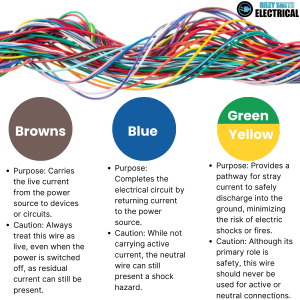Electrical work involves an intricate system of wires, circuits, and connections that ensure the safe delivery of power. Central to this system is understanding wire colour codes, a standardized scheme that helps identify the function of each wire. In Australia, following these codes is not only a matter of best practice but also a legal requirement under the Australian/New Zealand Wiring Rules (AS/NZS 3000). This guide dives deeply into the wire colour codes in Australia, outlining their significance, variations, and practical application in both domestic and commercial settings.
Whether you’re a professional electrician or a homeowner seeking clarity, this article unpacks everything you need to know about wire colour codes in the Australian context.
Why Wire Colour Codes Are Crucial
Wire colour codes are a universal language in the electrical world, providing vital safety cues to prevent accidents, ensure compatibility, and facilitate maintenance. Misinterpreting these codes can lead to dangerous situations, such as short circuits, electrical fires, or electrocution. Adhering to the Australian colour standards ensures that electrical systems function correctly and comply with national regulations.
The Evolution of Wire Colour Codes
Australia’s wire colour codes have evolved significantly over the years to align with international standards. Historically, older systems used a different set of colour designations, which have since been updated to conform to global IEC (International Electrotechnical Commission) standards. Electricians working with older installations must be aware of these outdated systems to navigate upgrades or repairs effectively.
Current Wire Colour Codes in Australia (Post-2000 Standard)
In 2000, Australia adopted the IEC colour code system to ensure consistency and global uniformity. Here’s a breakdown of the wire colour codes currently in use:
Pre-2000 Wire Colour Codes (For Legacy Systems)
Older electrical systems installed before 2000 may follow a different wiring code. Below are the historical wire colours:
- Active Wire: Red
- Neutral Wire: Black
- Earth Wire: Green
When upgrading or working on pre-2000 installations, electricians must use extreme caution and clearly label any new wiring to avoid confusion.
Wire Colour Codes for Three-Phase Systems
Three-phase systems, often used in industrial or commercial settings, require additional wire distinctions. The current wire colours for three-phase wiring in Australia are:
- Phase 1: Brown
- Phase 2: Black
- Phase 3: Grey
- Neutral: Blue
- Earth: Green with Yellow Stripe
For legacy systems, the colours were:
- Phase 1: Red
- Phase 2: White
- Phase 3: Blue
- Neutral: Black
- Earth: Green
Transitioning from older systems to newer ones requires careful planning and clear documentation to ensure compliance and safety.
Common Applications of Wire Colour Codes
1. Domestic Wiring
Residential properties typically use single-phase systems. The standard colours—brown (active), blue (neutral), and green/yellow (earth)—are predominant. Proper labelling and adherence to these codes are essential during renovations or new installations.
2. Commercial and Industrial Wiring
Larger establishments often rely on three-phase systems to handle higher electrical loads. The additional phase wires must be carefully distinguished and properly connected to ensure system reliability and safety.
3. Appliance Wiring
Many household and industrial appliances use the same colour codes as the building’s electrical systems, though exceptions exist. Always refer to the manufacturer’s specifications when wiring appliances.
Tips for Working with Electrical Wire Colour Codes
1. Double-Check Codes During Repairs
For older buildings, always verify wire colours before making assumptions. Legacy wiring systems can introduce complications, and misidentification may lead to costly errors or safety risks.
2. Use Proper Tools and Equipment
Testing tools, such as multimeters and voltage testers, should always be used to confirm wire functionality before proceeding with any work.
3. Label Wires Clearly
When adding or replacing wiring, use clear labels to indicate function, especially in complex systems. Proper labelling reduces confusion for future electricians or maintenance personnel.
4. Stay Compliant with Regulations
The AS/NZS 3000 standard is legally binding for all electrical work in Australia. Non-compliance can result in severe penalties, including fines or voided insurance claims in the event of electrical failures.
Common Mistakes to Avoid
- Assuming Legacy Colours are Current
When working with older systems, assuming they adhere to modern colour codes is a dangerous mistake. Always test and verify before proceeding. - Mixing Up Neutral and Earth Wires
Confusing the neutral wire with the earth wire can lead to hazardous conditions, including electrical shock risks. - Improper Labelling
Failure to label wires in multi-phase or complex systems can create confusion, leading to future errors and potential safety hazards. - DIY Electrical Work Without Proper Knowledge
Untrained individuals attempting electrical work often overlook critical safety standards. Hiring a licensed electrician ensures adherence to the correct wire colour codes and compliance with legal requirements.
The Role of Licensed Electricians
Professional electricians possess the training and expertise to navigate Australia’s wire colour codes seamlessly. They ensure all wiring work complies with legal standards and prioritize safety above all else. Moreover, hiring a licensed electrician provides peace of mind, as their work is typically backed by warranties and insurance coverage.
Future Changes to Wire Colour Standards
While the current standards are well-established, ongoing technological advancements and international collaborations may prompt updates to the AS/NZS 3000 guidelines. Electricians should remain vigilant, staying informed about any future changes to ensure their work remains compliant.
Conclusion
Wire colour codes are the foundation of safe and efficient electrical systems in Australia. Understanding the purpose and proper use of each wire—whether for domestic, commercial, or industrial applications—is critical to ensuring compliance and minimizing risks. With clear guidelines for both current and legacy systems, this comprehensive guide serves as an essential resource for anyone working with electrical wiring.
For complex installations or upgrades, always engage a licensed electrician to ensure adherence to Australian standards. Safety should never be compromised when working with electricity.
Need Professional Help?
If you’re unsure about your electrical wiring or need assistance with a project, contact a Riley Smith Electrical licensed electrician. Professional help ensures compliance with wire colour codes and guarantees long-term safety for your property.

